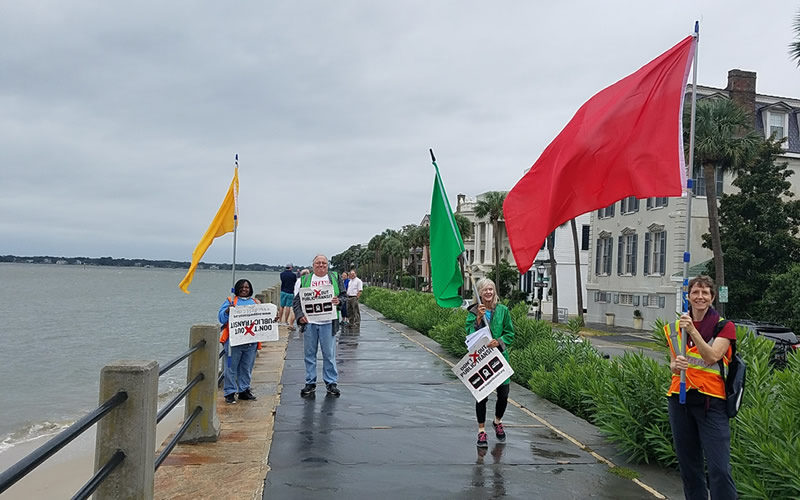
Public transportation advocates march at the Battery on Sept. 10, the day before Irma drenched the Lowcountry. Photo provided.
By William J. Hamilton | Best Friends of Lowcountry Transit became aware that the Lowcountry’s Emergency Bus Evacuation System, another almost entirely separate transit system from Tri County Link and CARTA, wasn’t ready for a major hurricane on Sept. 5. We blogged the issue and informed local officials with a positively focused post on the Daily Kos, a national news site titled Power and Efficiency of Public Transit can save Low country lives before and after a Hurricane.
Neither CARTA bus drivers nor the public had any detailed knowledge of this alternative bus route system. Maps and schedules could have been handed out to transit riders, who often come from households without private cars and communities where cars are less available. These people were uninformed as the storm approached. Public information was limited to a list of pickup stops, in the hurricane guide. Three locations — Whitesides school, Belle Hall and “future site of Lucy Beckham High School — were listed as being north of the IOP connector. They’re south of it.
Almost all of the evacuation coverage focused on the people most able to protect themselves by evacuating, households with private automobiles and disposable funds. The overwhelming plight of a single mother of two with a pet and no funds or a disabled person was largely unstudied.
When it became clear we might take a hit, we began checking the locations indicated for bus stops for this system on Thursday evening. In Mount Pleasant, we could not find signs at three of six locations: Belk at Town Centre; Moultrie Middle School and East Cooper Plaza. Employees at Doctor’s Care and the Gym at East Cooper Plaza had no knowledge of the stop’s location. Security at Town Centre knew nothing about a stop.
The stop location at the future site of Lucy Beckham High School, the old Wando high school location, was open and isolated between Mathis Ferry Road and construction site fencing. Stops at the library on Mathis Ferry Road and Belle Hall School had signs less than 200 feet from a rain shelter under the entrances to those public buildings. It wasn’t clear if bus riders were expected to wait in the wind and the rain by the road or under cover.
We blogged some of these issues on Sept. 7 and again sent our concerns to local officials on the Daily KOS: Help Us Find the Missing and Defective Charleston Hurricane Evacuation Bus Stops.
There was some increase in activity regarding the evacuation system. Announcements about CARTA bus service and the Emergency system weren’t coordinated. Many people were told or believed the stops would be serviced by regular CARTA buses.
On Sunday, Sept. 10, we marched through downtown Charleston to raise awareness, repurposing an earlier scheduled event to the circumstances. We handed out flyers to hundreds of people and visited the Hugo Memorial at High Battery. When we attempted to hand a flyer to the relative of a prominent local official who worked on that official’s campaign, but he declined it, telling us he was already familiar with our material, in this case, a new flyer with updated information which hadn’t been released online. You can read a copy of that flyer raising our concerns here.
After our small, soggy march where we met many evacuees from Florida, we checked the Westwood Plaza stop west of the Ashley. We found a sign on Sam Rittenberg Boulevard. We were at the stop 10 minutes taking pictures. As we prepared to leave, we noticed a school bus parked 250 feet away from the designated stop location in the parking lot. It had no taped-on signs or other markings indicated it was providing Hurricane evacuation service. The driver, though friendly and helpful, didn’t know where the stop actually was and hadn’t seen us there.
Reports Sunday from James Island indicated missing signs at some of its stops and buses making stops at locations, not on the stop list.
Had the Charleston area needed to evacuate thousands of poor, disabled, elderly and transportationally-disadvantaged persons in the face of a rapidly approaching Category 5 Hurricane as appeared possible Sept. 6, our community would not have been ready. We are very lucky today, but this pattern of failure says things about our community similar to the daily failure of our regular CARTA transit system.
Almost a year after Charleston County Voters approved $600 million in Help penny sales tax funding to improve transit here, we still can’t get people to work, to the beach so they can enjoy themselves, to places they need to visit early or late, or to high ground if a hurricane is approaching. The only really official action we’ve seen is the near automatic reappointment of incumbent CARTA board members, the start of another study and the reappropriation of $11 million in bus transit funding to be used as an interest-free loan for road construction.
Failures like these killed hundreds of people in New Orleans during Katrina. We can and should do better.
William J. Hamilton of Mount Pleasant is an attorney and public transportation advocate who organizes Best Friends of Lowcountry Transit and other efforts.
- Have a comment? Send to: editor@charlestoncurrents.com




 We Can Do Better, South Carolina!
We Can Do Better, South Carolina!

























3 Comments